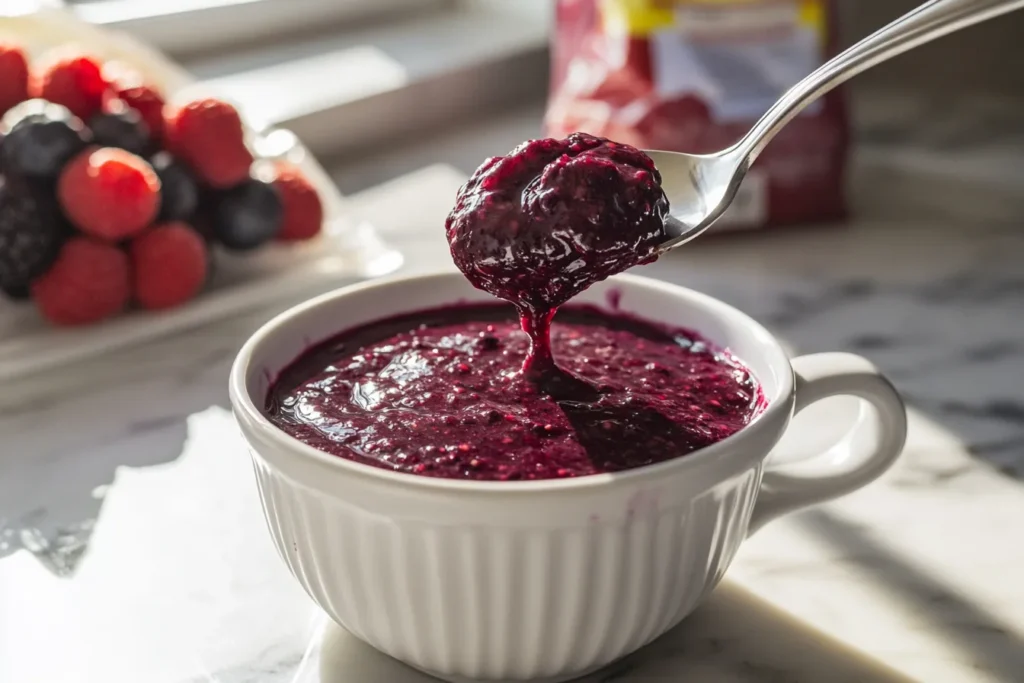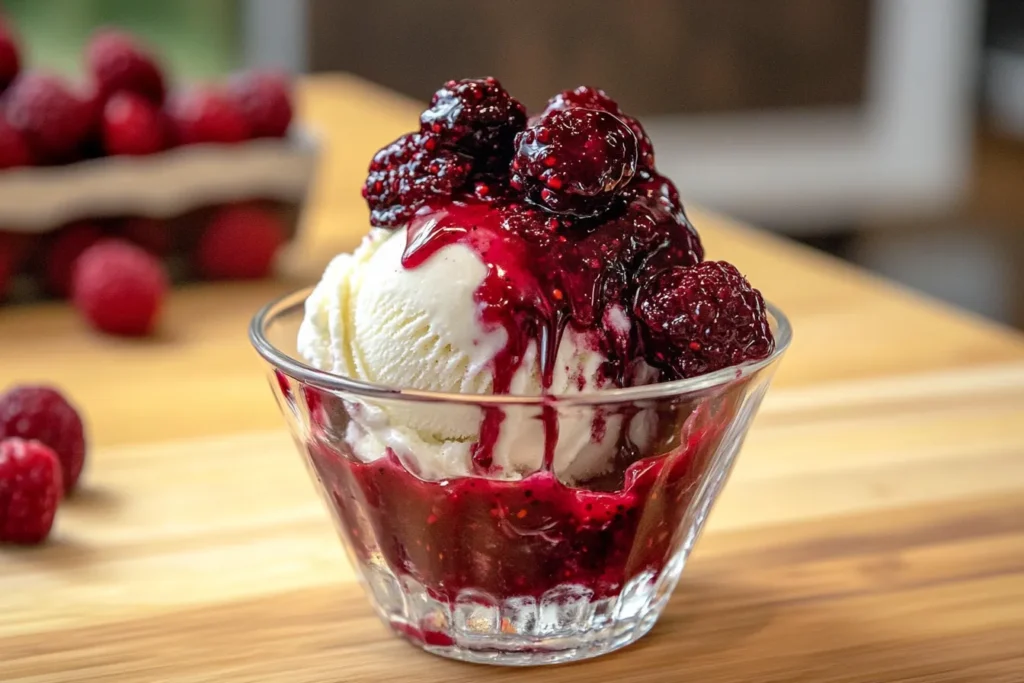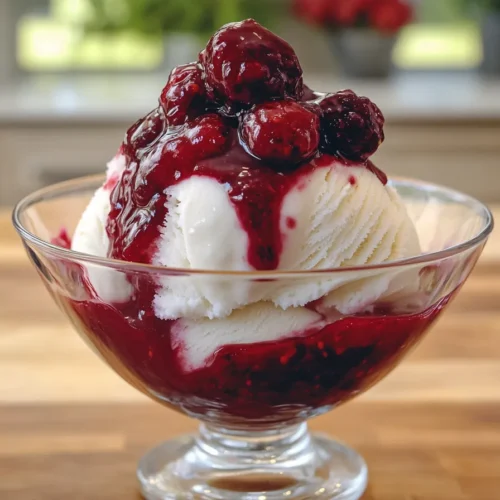Table of Contents
Wojapi is a cherished Native American dish that has been passed down through generations, offering a delicious and culturally significant way to enjoy berries. This rich, thick berry sauce is a staple in many Indigenous communities, particularly among the Lakota, Dakota, and other Plains tribes. Traditionally made with wild berries, Wojapi embodies the deep connection between Native American culture and the natural world.
Unlike commercial fruit sauces, this traditional Native American berry dish is often made without added sugar, relying on the natural sweetness of berries. Over time, some modern variations have introduced honey, cornstarch, or other thickeners for a smoother texture. However, the essence of this Indigenous fruit sauce remains unchanged—a simple, wholesome dish enjoyed at gatherings and family meals.
This guide explores its origins, cultural significance, preparation methods, health benefits, and how to make it at home. Whether you’re new to this dish or reconnecting with Indigenous culinary traditions, you’ll find everything you need to know here.
The Origins of Wojapi – A Dish Rooted in Native American History
This traditional Native American berry dish has deep roots in Indigenous history, particularly among the Lakota, Dakota, and Nakota peoples of the Great Plains. These tribes have long relied on the natural bounty of the land, gathering wild berries such as chokecherries, buffalo berries, and serviceberries to create nutrient-rich dishes. This Indigenous fruit sauce was developed as a way to preserve these fruits and enjoy their flavors throughout the seasons.
A Dish Born from Necessity and Tradition
Before the arrival of European settlers, Native American tribes had no refined sugar or modern preservatives. Instead, they utilized drying, boiling, and other natural methods to prepare and store food. Wojapi was traditionally made by slowly simmering berries over an open fire, creating a thick, naturally sweetened sauce. This method allowed tribes to make use of seasonal berries and ensure they had nourishing food available during colder months.
Wojapi’s Role in Tribal Life
Wojapi was more than just a food item; it held cultural and spiritual significance. It was commonly prepared during ceremonies, feasts, and tribal gatherings, symbolizing unity, sustenance, and gratitude for nature’s gifts. The dish was often shared in large gatherings, reinforcing the importance of community and storytelling around the fire.
As Indigenous cuisine evolved, this traditional berry sauce remained a staple, passed down through generations. Today, it continues to be a key part of Native American food heritage, preserving the flavors and traditions of the past while adapting to modern cooking techniques.

Evolution of Wojapi Over the Years
While Wojapi remains deeply tied to its traditional roots, it has also evolved over time. The way it is prepared, the ingredients used, and even how it is served have changed due to influences from modern cooking techniques and the availability of different ingredients.
From Wild Berries to Store-Bought Ingredients
Originally, this traditional Native American berry dish was made using wild fruits like chokecherries, buffalo berries, and juneberries, which were foraged by Indigenous tribes. These berries provided natural tartness and sweetness, along with essential nutrients. Today, with easier access to grocery stores, many people prepare this Indigenous fruit sauce using store-bought berries such as blueberries, raspberries, strawberries, and blackberries. While these substitutions maintain the essence of the dish, they offer a slightly different flavor profile compared to traditional wild berries.
The Introduction of Sweeteners and Thickeners
Traditional Wojapi was made without sweeteners, relying on the natural sugars in the berries. However, modern versions often incorporate honey, maple syrup, or even sugar to enhance the sweetness. Additionally, some recipes use cornstarch or flour to thicken the sauce, creating a smoother, pudding-like consistency. While these additions make it more adaptable to contemporary tastes, purists still prefer the traditional method of simply simmering berries to achieve the desired texture.
Modern Serving Styles
Historically, Wojapi was eaten on its own or paired with traditional frybread. Today, people have found creative ways to incorporate it into different meals. Some use it as a topping for pancakes, waffles, or yogurt, while others drizzle it over ice cream or use it as a filling for pastries. Even restaurants specializing in Indigenous cuisine have started featuring it in innovative dishes, blending tradition with modern culinary artistry.
Ingredients and Traditional Preparation of Wojapi
Wojapi is known for its simplicity, relying on just a few natural ingredients to create a rich, flavorful berry sauce. Traditionally, this dish was made using wild berries found in the Great Plains and other Indigenous regions, but modern adaptations have made it more accessible to those who may not have access to these native fruits.
Essential Ingredients for Traditional Wojapi
The key to making an authentic Indigenous berry sauce lies in using fresh, high-quality ingredients. Here are the traditional components of this dish:
- Berries – The foundation of this Native American fruit dish, traditionally made with chokecherries, juneberries, buffalo berries, or blackberries. Modern versions often use blueberries, raspberries, or strawberries.
- Water – Helps break down the berries during the cooking process.
- Optional Sweeteners – Some modern recipes include honey, maple syrup, or sugar, though the traditional version relied only on the natural sweetness of the berries.
- Optional Thickeners – Traditionally, the berry sauce is naturally thick, but some modern adaptations use cornstarch or flour for a smoother consistency.
Step-by-Step Traditional Preparation
- Gather and Clean the Berries – If using wild berries, rinse them thoroughly to remove any dirt or debris. Store-bought berries should also be washed to remove any pesticides or preservatives.
- Simmer the Berries – Place the berries in a pot with a small amount of water and let them cook over medium heat, stirring occasionally. The berries will begin to break down and release their juices.
- Mash or Blend (Optional) – Traditionally, the berries were mashed using a wooden spoon or stone tool. Some modern versions use a blender or food processor for a smoother texture.
- Thicken the Sauce (Optional) – If a thicker consistency is desired, a small amount of cornstarch or flour can be mixed with water and added to the simmering berries.
- Serve Warm or Chilled – Wojapi can be enjoyed immediately or allowed to cool before serving. It pairs well with frybread, pancakes, or even as a dip for desserts.
Traditional Wojapi is a simple yet flavorful dish that requires little effort but offers a deep connection to Native American culinary heritage. Whether made in its purest form or with slight modifications, it remains a beloved dish in Indigenous communities and beyond.
The Best Berries for Making Wojapi
The berries used in Wojapi define its flavor and texture. Traditionally, Native Americans used wild berries, but today, both wild and store-bought options work well.
Traditional Wild Berries
- Chokecherries – Tart and slightly bitter, commonly used by Indigenous tribes.
- Buffalo Berries – Small, red, and tangy with a hint of sweetness.
- Juneberries (Serviceberries) – Similar to blueberries but earthier and mildly sweet.
- Blackberries – Deep, rich sweetness that enhances Wojapi’s flavor.
Modern Store-Bought Alternatives
- Blueberries – Sweet and vibrant, great for a milder flavor.
- Raspberries – Slightly tart, adding a nice balance.
- Strawberries – Naturally sweet, making Wojapi smoother.
- Mixed Berry Blends – Combines flavors for a complex taste.
Fresh vs. Frozen Berries
- Fresh Berries – Retain natural tartness and texture.
- Frozen Berries – Convenient but may need less water due to extra moisture.

Traditional Cooking Methods vs. Modern Techniques
Wojapi has evolved from its original preparation methods, though the essence remains the same.
Traditional Cooking Methods
- Open-Fire Simmering – Berries were slowly cooked over an open flame, allowing them to break down naturally.
- Stone or Wooden Tools – Berries were mashed manually to create a thick consistency.
- No Sweeteners or Thickeners – The natural berry juices provided all the flavor and texture.
Modern Techniques
- Stovetop Cooking – Berries are simmered in a pot for convenience.
- Blenders or Food Processors – Used for a smoother texture.
- Added Thickeners – Cornstarch or flour can be used for a pudding-like consistency.
Both methods preserve the rich flavor of Wojapi, but modern techniques make it quicker and more adaptable.
Health Benefits of Wojapi
Wojapi is more than just a flavorful dish—it’s packed with nutrients that offer various health benefits. Made primarily from berries, it provides a natural source of vitamins, antioxidants, and fiber while being free from processed sugars in its traditional form.
Rich in Antioxidants and Nutrients
Berries used in Wojapi, such as chokecherries, blueberries, and raspberries, are loaded with antioxidants. These compounds help reduce oxidative stress, lower inflammation, and protect cells from damage. Regular consumption of antioxidant-rich foods is linked to a reduced risk of chronic diseases such as heart disease and diabetes.
Additionally, Wojapi is a great source of essential vitamins and minerals:
- Vitamin C – Strengthens the immune system and promotes skin health.
- Fiber – Supports digestion, promotes gut health, and aids in maintaining a healthy weight.
- Potassium – Helps regulate blood pressure and supports heart health.
A Naturally Sweet and Healthy Alternative
One of the biggest advantages of this Indigenous berry sauce is its natural sweetness. Unlike processed jams or syrups that contain high amounts of refined sugar, the traditional version relies on the pure flavors of berries. Some modern adaptations include honey or maple syrup for added sweetness, making it a healthier alternative to artificially sweetened desserts.
This Native American fruit dish fits well into a balanced diet, offering both delicious taste and nutritional benefits. Whether enjoyed on its own or as a topping, it’s a wholesome treat that supports overall well-being.

Wojapi Recipe
Equipment
- Medium Saucepan
- Wooden spoon or whisk
- Measuring cups
Ingredients
- 3 cups mixed wild berries chokecherries, blueberries, blackberries, or strawberries
- 1/2 cup water
- 1/4 cup honey or maple syrup adjust for sweetness
- 1 tablespoon cornstarch optional, for thickening
- 1 tablespoon cold water if using cornstarch
Instructions
- Place berries and 1/2 cup of water in a medium saucepan over medium heat.
- Simmer, stirring occasionally, until the berries break down and release their juices (about 10 minutes).
- Mash berries with a spoon or leave chunky, depending on desired texture.
- Stir in honey or maple syrup, adjusting to taste.
- If a thicker consistency is desired, mix cornstarch with 1 tablespoon of cold water and stir into the sauce.
- Simmer for another 3–5 minutes, stirring constantly, until thickened.
- Remove from heat and let cool slightly before serving.
Video
Notes
- Traditionally, Wojapi is made without cornstarch, resulting in a naturally thickened sauce.
- Store in an airtight container in the refrigerator for up to 5 days.
- Serve with frybread, pancakes, or over ice cream for a delicious topping.
- Try mixing different berries for unique flavor variations.
How to Make Wojapi at Home – A Step-by-Step Guide
Making Wojapi at home is simple and requires only a few ingredients. Whether you prefer the traditional method or a modern variation, this step-by-step guide will help you prepare a delicious and authentic Wojapi.
Traditional Wojapi Recipe
Ingredients:
- 2 cups of fresh or frozen berries (chokecherries, blueberries, raspberries, or a mix)
- ½ cup of water
- Optional: 1–2 tablespoons of honey or maple syrup (for sweetness)
- Optional: 1 teaspoon of cornstarch mixed with water (for thickening)
Instructions:
- Prepare the Berries: Rinse fresh berries thoroughly. If using frozen berries, allow them to thaw slightly.
- Simmer the Berries: In a medium saucepan, combine berries and water. Cook over medium heat, stirring occasionally. The berries will start to break down and release their juices.
- Mash or Blend (Optional): For a smoother consistency, mash the berries with a spoon or blend them for a puree-like texture.
- Sweeten (If Desired): If the berries are too tart, add honey or maple syrup to taste.
- Thicken (Optional): If a thicker consistency is preferred, mix cornstarch with a little water and stir it into the sauce. Let it simmer for another minute until thickened.
- Serve Warm or Chilled: Enjoy Wojapi as a dip, spread, or dessert topping.
Modern Variations and Flavor Enhancements
- Add a splash of lemon juice for a tangy twist.
- Mix different berries for a unique flavor profile.
- Use Wojapi as a topping for pancakes, yogurt, or ice cream.
This homemade Wojapi recipe allows you to experience the rich flavors of a time-honored Native American dish in a simple and healthy way.
Frequently Asked Questions (FAQ) About Wojapi
What is Wojapi?
Wojapi is a traditional Native American berry sauce made by simmering berries into a thick, naturally sweet dish. It is often served with frybread or used as a topping for various foods.
How do you pronounce the name Wojapi?
Wojapi is pronounced “wo-ZHAH-pee”, with an emphasis on the second syllable.
How do you make Wojapi?
To make Wojapi, berries are simmered with water until they break down into a thick sauce. Traditional recipes do not include sweeteners, but modern versions may add honey or maple syrup. Some variations also use cornstarch to thicken the mixture.
Where is Wojapi from?
Wojapi originates from Native American tribes, particularly the Lakota, Dakota, and Nakota peoples of the Great Plains. It has been a staple in Indigenous cuisine for generations.
Conclusion
Wojapi is more than just a berry sauce; it is a reflection of Native American culinary heritage, resilience, and tradition. Passed down through generations, this simple yet flavorful dish remains a staple in Indigenous communities, connecting people to their ancestors and the natural world.
While traditional Wojapi stays true to its roots with wild berries and natural thickening methods, modern adaptations have made it accessible to a broader audience. Whether enjoyed with frybread, as a topping for breakfast foods, or incorporated into contemporary recipes, Wojapi continues to be a cherished part of Native American cuisine.
By making and sharing Wojapi, we not only celebrate its delicious flavors but also help preserve an important piece of Indigenous food culture. Whether you are experiencing it for the first time or honoring a family tradition, Wojapi offers a taste of history in every bite.


1 thought on “Wojapi: The Traditional Native American Berry Dish”